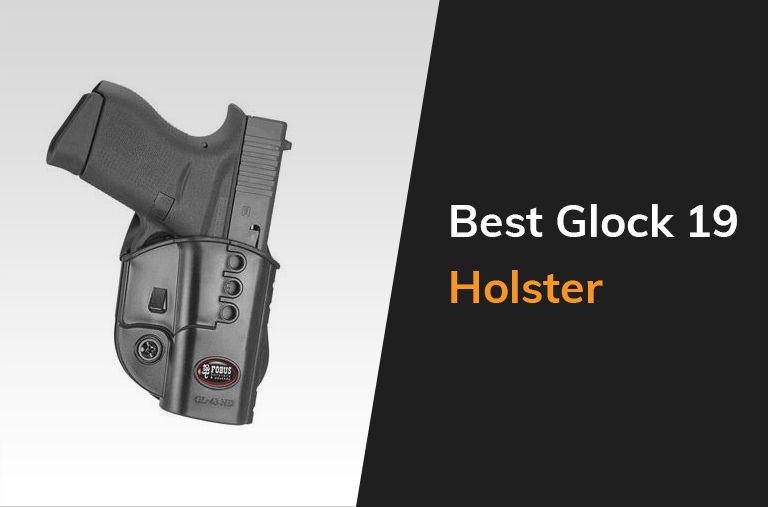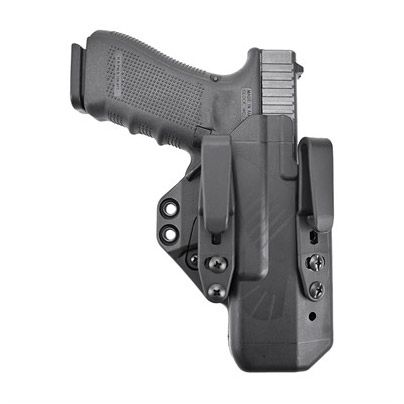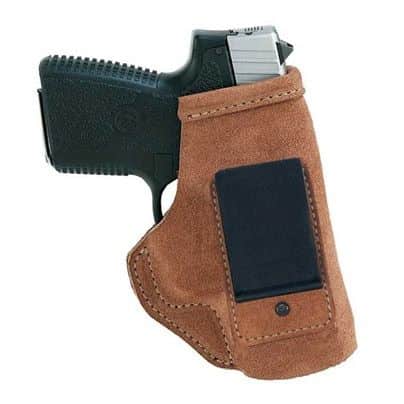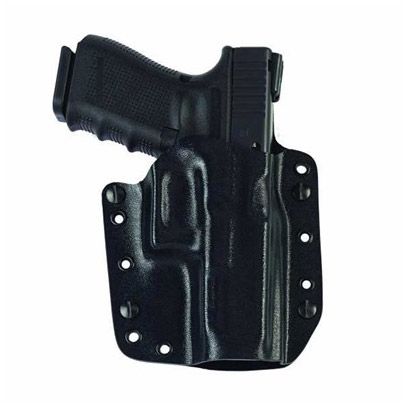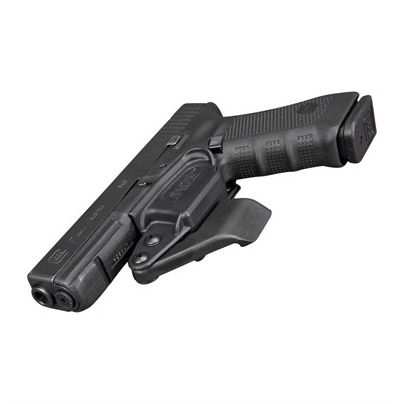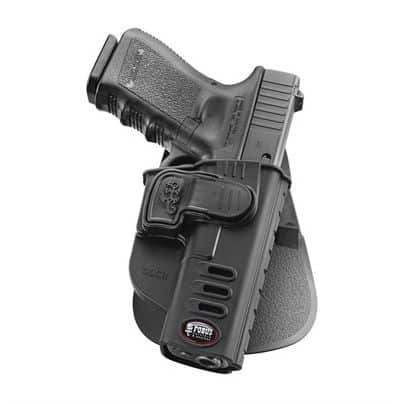At a Glance: Best Glock 19 Holsters
- OUR TOP PICK: Fobus Evolution holster with right-hand paddle
- RUNNER UP: Blackhawk SERPA CQC polymer holster
- BEST BUDGET OPTION: Muddy River Tactical tuckable inside waistband holster
Comparison of The Best Glock 19 Holsters
| PRODUCT | DETAILS | ||
|---|---|---|---|
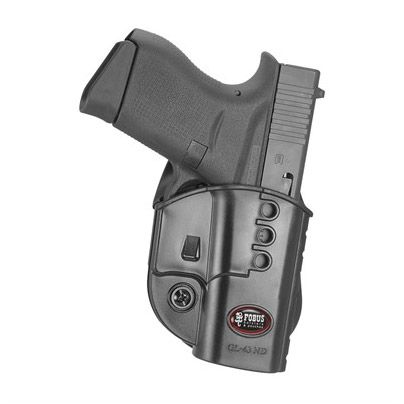
Our Top Pick
|
Fobus Evolution holster with right-hand paddle |
|
View Latest Price |
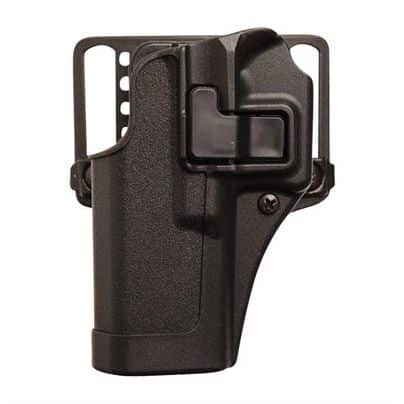
Our Top Pick
|
Blackhawk SERPA CQC polymer holster |
|
View Latest Price |
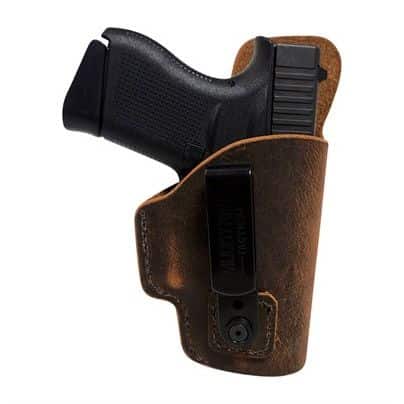
Our Top Pick
|
Muddy River Tactical tuckable inside waistband holster |
|
View Latest Price |
The Glock 19 is the go-to concealed carry weapon for many civilians. It’s also the favored firearm for many law enforcement agencies and military organizations, not just in the USA but worldwide.
If you’re planning to carry your Glock 19 around with you, you’ll need a holster to do so safely and protectively. Luckily, it’s not hard to find a holster that’s compatible with Glock 19s. However, it’s worth reading up on how to find the best Glock 19 holster to ensure your new accessory is the safest and most reliable one on the market.
Our Pick Of The 8 Best Glock 19 Holsters Available
We have sifted through the countless holsters on the market to find the highest quality products out there. We’ve tested 8 of the best ones and thoroughly reviewed them to help you choose the holster that’s most suited to you. Moreover, we’ve included a breakdown of the pros and cons of each one for easy comparison.
Read next: The Best Upgrades for Your Glock
Fobus Evolution holster with right-hand paddle
The Fobus Evolution holster is a passive retention holster that features a one-piece body construction and an adjustable retention screw. The screw is not pre-set so allows for adjustable retention pressure.
This holster has some great little features such as a protected sight channel, steel-reinforced rivet attachment, a belt clip, and a rubberized paddle backing to give extra stability and comfort. Furthermore, the low profile design of this holster makes it a great choice for concealability.
The holster has a black Kydex polymer build and is designed for right-handed users. This particular model is compatible not only with Glock 19 and 19X but also with a range of others such as the 17, 22, 23, 31, 32, 34, 35, and 45.
What I like about the Fobus Evolution Holster is how lightweight and compact it is. The adjustable retention screw is a great feature as it allows you to find the optimum hold for your pistol.
I found it super easy to put the holster on and take it off. However, it does not give the smoothest draw and you cannot draw your gun at an angle. You have to pull very sharply and straight up to unseat the gun which leaves no room for error.
Pros
- Adjustable retention pressure
- Rubberized paddle backing for stability and comfort
- Low profile design for concealment
- Lightweight and compact
- Easy to take on and off
Cons
- Drawing the gun is not the smoothest
Blackhawk SERPA CQC Concealment holster
The Blackhawk SERPA CQC holster automatically locks your Glock 19 in place every time you holster the pistol. This prevents any chance of it falling out. Not only does it lock firmly in place but it also releases instantly and easily during each draw.
The SERPA features a trigger guard lock that initiates an instant engagement whenever the pistol is holstered. The click gives an audible click to verify that your gun is secured. The lock is easily disengaged by pressing your trigger finger against the release button as part of a natural draw motion.
The OWB holster can be worn on a belt or used as a paddle holster. The strapless design means nothing will get in the way when drawing your weapon. Meanwhile, the low profile means it can easily be concealed.
The USA made holster is designed for right-hand use and is made from a tough injection-molded polymer. This holster provides great value considering the amount of adjustment and attachment methods.
It holds the gun tight and secure, gives a good release, and places your trigger finger at the ready. However, the one downside I found was that my Glock didn’t hug my body as well as it did with other holsters.
Pros
- Gives a super quick release
- Automatic lock for supreme security
- 2 different attachment methods
- Low profile for concealed carry
Cons
- Does not hug the body as well as it could
Muddy River Tactical tuckable inside waistband holster
This tuckable inside the waistband holster from Muddy River Tactical is made from high quality 10-11oz Water Buffalo leather to create an extremely durable and soft holster. This material choice gives you the utmost comfort when wearing it. The IWB design makes it a great choice for concealed carry too.
A cool feature of this leather holster is a sweat shield to protect your body from the firearm. I love the soft suede-like feel on the outside of the holster. It feels comfortable against my body and makes it a pleasure to carry.
Another brilliant aspect of this unique Glock holster is that you get to finish the molding process. This allows you to mold the holster to your firearm and body in the exact position you desire. Not everyone has the same body shape or carry preferences so this customizable fitting makes it one of the best Glock 19 holsters out there.
Handcrafted in the USA, the right-handed Glock 19 model also fits 19X and 23. It’s not the cheapest Glock holster on the market, but it’s adaptability, concealed carry, and cool design make it great value for money nonetheless.
Pros
- High-quality leather for durability and softness
- Comfortable feel against your body
- You can mold the holster to your Glock and body
- A great choice for concealed carry
- Unique look
Cons
- A bit more expensive than others
Raven Concealment Systems Eidolon holster
The Eidolon holster from Raven Concealment Systems was created from three years of design and development. It is designed to give impressive concealed carry, as well as be the most refined and functional inside-the-waistband holster on the market.
The shell of the holster precisely fits the weapon on the inside. It can be used in nearly any carry position with maximum comfort and concealment. It also has attachment points for an array of accessories. This lets you tailor the holster to your specific carry needs.
The Eidolon features innovative adjustable retention that isolates the tension on only the front of the trigger guard. This gives an extremely clean feel when drawing and holstering with minimal adjustment. This system is tuckable and is excellent for IWB carry for right-handed shooters.
The holster kit includes a holster Ambi shell, a pair of 1.5 overhook belt attachments, and a tall spacer for mounting the belt attachment below the trigger guard. I found the adjustable retention worked very well and the holster did a great job of keeping my Glock concealed in AIWB carry.
It is a little bulky but that seems to aid in its ability to stay in place and conceal. It’s also an expensive option but if you’re looking to carry in the appendix position this could be the best Glock 19 holster for you as it’s probably the most comfortable holster for appendix carry.
Pros
- Great adjustable retention system
- Can be used in multiple carry positions including AIWB
- Best choice for appendix carry
- Gives top comfort and concealment
Cons
- Fairly expensive
Galco International Stow-N-Go holster
The Galco International Stow-N-Go concealed carry holster combines a fast draw with a smooth and easy return. The open-top design gives an impressively fast draw. The holsters reinforced mouth then allows a smooth and easy return to the holster.
The leather holster can be used from multiple positions, including strong side, crossdraw, or in front of the hip (appendix carry). It firmly secures onto your belt thanks to the sturdy injection-molded nylon clip.
The holster carries your Glock in a vertical orientation when fitted inside the pants, with no cant or angle. The holster is constructed from a premium Center Cut Steerhide giving maximum comfort, and it fits belts up to 1 3/4″.
The holster’s versatility is fabulous, offering a choice of carrying positions to meet the needs of all Glock users. Overall, it’s an affordable product and is fantastic value for money considering what it offers. h
Pros
- The open-top design gives a fast draw
- Reinforced mouth for a smooth and easy return
- Wide range of carrying positions available
- The sturdy clip gives a secure hold
- Very comfortable fit once the leather breaks in
- Fantastic value for money
Cons
- None
Galco International Corvus holster
The Corvus holster from Galco International is one of the best Glock 19 holsters for serious gun users as it gives you two fast, concealable holsters in one. The Corvus swiftly and easily converts from a belt carry holster to a concealable inside-the-waistband design.
The open-top style gives a fast draw and the holster features adjustment for ride height and cant. It also features a raised sweat guard to protect both the pistol and the wearer. The 2-in-1 holster is constructed from Kydex polymer with comfortable forward molding.
The Corvus comes complete with belt slots in both 1.5″ and 1.75″ widths and straps for converting it to inside the waistband carry. The modern layout is designed to accommodate most carry-style optical sights. In contrast, the deep sight rail accommodates suppressor-height sights.
This versatile holster is a superior holster choice for Glock users and a top choice for defensive carry purposes. As you would expect, it’s not the cheapest model on the list. Still, with the unique convertible carry design, it’s undoubtedly a strong contender for the best Glock 19 holster.
Pros
- Two fast, concealable holsters in one
- An open-top style for fast drawing
- Top choice for defensive carry
- Excellent quality and fit
Cons
- None
Raven Concealment Systems Vanguard 2 advanced holster
The VanGuard 2 advanced holster from Raven Concealment Systems is an upgraded version of their VanGuard 2 minimalist IWB holster. What makes the VG2 advanced holster stand out from the rest is that it only covers the trigger guard of the Glock, unlike most other IWB holsters.
This unique design eliminates the bulk of a traditional holster while giving a much higher safety and security level than carrying your Glock concealed without a holster, such as tucked into the waistband of your pants.
The VG2 holster features the renowned RCS CLAW taking the accessory’s concealability to the next level. The RCS CLAW leverages the pistol’s grip close to the body, while still allowing for clean, repeatable draws.
Furthermore, it can be equipped with either a tuckable strut with an overhook or tuckable strut with a soft loop. This lets you choose your preferred belt interface system, giving you the most comfortable wear. This combination is adjustable for ride-height and cant.
The black IWB holster is made from tough, durable Kydex Polymer and offers ambidextrous use – the only one on the list to do so! This makes it undoubtedly the best Glock 19 holster for lefties (and also right-handed shooters) looking for a lightweight, compact model to enhance concealability.
Pros
- Compact, lightweight option for the best concealment
- Gives comfortable wear with no imprint left on your skin
- Fully ambidextrous
- RCS CLAW that leverages the pistol grip close to you
- An adjustable belt interface system
Cons
- Only covers the trigger guard which may not give enough protection for some
Fobus CH-series paddle holster
The Fobus CH paddle holster offers a trigger guard locking mechanism that gives active retention while allowing an unhampered presentation of the pistol. The holster also features a rubberized paddle insert to give extra stability and comfort and prevent your weapon from digging into your body.
The OWB holster has an integrated release button that is located at a place on the holster that’s naturally reachable, well above the trigger. This allows you to release your Glock without having to alter your draw stroke.
The CH holster is available in both right-handed and left-handed models, giving left-handed Glock users a great holster option. The block holster has been made from a strong and reliable Kydex Polymer. As well as fitting Glock 19’s, it’s compatible with 17, 22, 23, 31, 32, 34, 35, and 45 models.
This is one of the toughest, high-quality crafted holsters on the market, and gives extremely fast and easy release thanks to the perfect positioning of the index finger release button. It’s one of the most affordable options we reviewed and one of the best products in terms of value for money too.
Pros
- Naturally positioned index finger release
- Provides level 2 retention without the need to alter the draw stroke
- Rapid release active retention system
- Rubberized paddle insert for stability and comfort
- Affordable price and great value
Cons
- None
What to look for in a Glock 19 holster
The most obvious job of a holster is to hold your Glock when you’re not using it. But it’s equally as important for your holster to protect your firearm, whether that’s from being dropped or from bumps and scrapes.
All the best Glock 19 holsters will also prevent accidental discharge. What’s more, they will give a quick draw when the situation calls for it, whether that’s in a competition or a defensive situation.
To find the best Glock 19 holster on the market, look for the following qualities.
Comfort
- Comfort is a factor you should consider before buying a holster, especially if choosing an inside waistband holster (IWB) as these can not only feel uncomfortable when moving around, but they can also rub against your skin.
- Rubbing is more common from holsters made of hard materials such as Polymers rather than soft ones like leather.
- Rubbing will lead to more irritation and you’ll need to wear something between your holster and your skin, although that doesn’t always solve the problem.
- You should also make sure that your holster doesn’t slip or shift, or feel like it does.
Protection
- A holster built with durable and protective materials will best shield your Glock 19 from any bumps and abrasion.
- For sufficient protection, opt for leather, nylon, or polymer holsters.
- Like Kydex, hard polymer holsters are popular choices because they can be custom-molded to any gun to give a perfect fit.
- Polymer models also give more protection against impacts.
- Hard Polymer holsters can create some scuffs on your Glock over time as you draw it from the holster repeatedly.
- To preserve your Glock’s finish, opt for either a softer holster or a hard holster that has a soft, protective lining.
Retention
- Simply put, a good holster should not let your gun fall out of it.
- A simple way to test for retention is to turn the holster upside down. If your gun stays firmly in place, you’ve got plenty of retention.
- A holster with good retention is vital if you ever find yourself in an altercation where you get knocked down. An ineffective holster would allow your gun to slip out, giving your attacker the chance to grab it before you recover.
- Even if it’s unlikely that you’ll end up in a combat situation, you’ll still want your holster to hold your gun firmly in place as you go about normal daily activities such as getting in and out of a vehicle.
To hold your gun in place, Glock holsters use an active retention system, a passive retention system, or both at once.
- An active retention system requires you to engage and disengage the retention system. This is most commonly seen in the form of thumb breaks or straps that need to be released before pulling the holster’s weapon.
- With a passive retention system, the scabbard (the part that holds the gun) fits snugly around your gun and is molded to its shape. This increases surface area contact, which creates friction to hold the gun securely in place.
- Many passive retention holsters have adjustable screws. This allows you to choose how tightly the scabbard fits around the gun and adjust the friction level.
- Passive systems typically allow quicker access than active systems but give less retention.
- Some holsters use both a passive retention system and an active retention system, giving the most secure hold.
Trigger coverage
As well as preventing your gun from falling out, your holster needs to cover your Glocks trigger to stop any accidental discharge. While this is not an issue with the vast majority of holsters, it’s still something you should check, and if possible, test out before buying.
Concealment
If you only plan on carrying your gun openly, concealability may not be a concern for you. However, if you don’t want your holster and gun to be visible when you wear it, this is something you should consider.
As everyone’s body type is unique, it’s worth trying out different holster types to get a feel for which one gives the most concealment for you. The type of clothes you wear will also play a role in how well you can conceal your weapon.
Types of Glock 19 holsters
Not all holsters are the same. These are the three holster types that you will come across in your search.
- IWB holsters
- Appendix IWB holsters
- OWB holsters
IWB (inside waistband) holsters
- The design of an IWB holster places your Glock between your underwear and your trousers. This makes it the IWB the best holster type for concealed carry.
- They are great for keeping your gun safe because they place it closer to your body than other holsters do.
- They also feature many mounting options such as spring clips and soft & hard belt loops.
- The standard position for the IWB holster is on your hip in the 3-4 o’clock position.
- Drawing can be harder and slower when using an IWB holster. This will depend on the clothing you wear though.
- These holsters can make crouching and sitting down less comfortable due to the positioning. This may be problematic for shooters needing to take low positions.
Appendix IWB holsters
- These are IWB holsters that can be worn on your hip and also in the Appendix position. They allow you to carry your pistol against your lower stomach/groin area.
- Appendix IWBs are ideal for carrying and concealing large handguns that don’t fit in a standard holster.
- Since Glock 19 is not a large gun, these holsters are not a common choice and should only be used by advanced shooters.
OWB holsters
- OWB holsters give an open carry method and are better for larger pistols.
- They give quick access to your weapon compared to IWBs. For this reason, they are the most common holster type used by police officers.
- The quick access also makes them a good choice for the range where you can practice drawing your gun.
- OWB holsters can either be mounted on your belt or between your belt and your body.
- They are carried in the same position as the IWB, on the hip at 3-4 o’clock.
- The downside to OWBs is that they are harder to conceal. You will need to wear a hoodie or jacket to hide your weapon.
You may also come across shoulder, pocket & ankle holsters on the market. However, I wouldn’t recommend choosing this style as many are too small for a Glock 19. Furthermore, waistband holsters give much better concealment & accessibility.
The best materials for your Glock 19 holster
Most holsters will either be made from leather or Kydex – a type of polymer. Here are the main differences between the two.
Leather
- Leather is a popular choice because of its ability to stretch.
- Leather holsters bend just enough to hold your Glock against your body in a very tight and secure way.
- They are a good choice if you’re looking for concealed carry.
- However, they don’t give a good fit initially as it takes some time for the leather to shape to your gun. Typically, it will require between 100-150 draws to fully break into a leather holster. After this though, it will fit your pistol like a glove.
Kydex
- Kydex is a type of polymer similar to plastic that’s commonly used to mold weapons.
- It’s a favored choice as it is durable and affordable.
- The downside of Kydex is that it doesn’t bend and can feel very hard against your body. This makes it less comfortable than leather.
You might also come across Glock holsters that are made from hybrid materials. This is a combination of Kydex and another material – usually leather. This gives a hard exterior side with a softer interior side. A Kydex/leather fusion can make the best Glock 19 holster as it conforms to your body and is much more comfortable than a full hard Kydex holster.
There are also nylon holsters on the market. These are usually cheaper and serve as a budget option but they are not as good as leather or Kydex ones. This is because they’re not molded to individual guns and they do not protect the trigger.
Can I use a generic, all-purpose holster?
The vast majority of holsters are designed to be compatible with specific guns, and for good reason. You may find some universal holsters on the market but these typically offer poor retention and poor attachment options.
While all-purpose holsters might be a cheaper option, they will not hold your gun as well as the models that are made especially for Glock 19s. Thanks to the popularity of the Glock 19, there’s a huge market of compatible holsters to choose from so there is no need to buy a generic product.
Which are better, holsters that go inside or outside the waistband?
In short, inside waistband holsters (IWB) will be the best Glock 19 holster for you if you want concealed carry. In all other cases, outside waistband holsters (OWB) will best serve you.
One thing to bear in mind though, inside waistband holsters can make it a little slower to draw your gun. If you need to draw your gun in a flash, an OWB holster may be more suited to you.
Is it legal to carry a Glock 19 around in a holster?
Firstly, there are different laws around open carrying and concealed carrying and these laws vary from state to state.
- For concealed carry, all 50 states in the USA have passed laws for individuals to carry certain concealed firearms in public.
- Some states allow concealed carry without a permit, whereas 34 states require you to first obtain a permit from a government authority.
- Nevertheless, some states that require permits for concealed carry will not issue them or will make it extremely difficult to obtain one.
- For open carry, 26 states permit it, 6 states permit it with local restrictions, and 13 states require individuals to obtain a license for open carrying.
It’s vital that you thoroughly check and fully understand your state’s laws before carrying your Glock around in either an open or concealed way.
Why are Glocks so dominant on the market?
Glock has an almost 65% market share of handguns in the U.S, making Glock a celebrity in the gun world. Glock is the preferred pistol for both law enforcement and civilians. But, what is it that makes Glock so popular?
- Glock is known for having spent considerable time and effort working on the “pointability” of the pistol.
- Pointability refers to the pistol’s natural ability to act as an extension of the shooter’s hand and eye coordination.
- The high pointability that Glock has obtained makes the pistol easier to aim than most of its competitors as well as being more user-friendly and accurate to shoot too.
- Gaston Glock came into the game knowing nothing about handguns. Surprisingly this is what he credits his success to. The lack of knowledge gave him no preconceived notions about what a handgun should be. This allowed him to focus on just a handful of requirements: ease of use, simplicity, and reliability., mastering them all.
Are there any good alternatives to carrying a Glock 19 in a holster?
It is possible to carry your Glock 19 without a holster. The most common method of carrying concealed without a holster is the belt carry method. Typically, you place the weapon inside the waistband of your pants. Other methods include carrying the gun in your pocket or bag.
The legality of carrying a gun in a concealed way without a holster varies from state to state. While in some states it may be legal to carry concealed without a holster, it is never a good idea to do so and is not something we would recommend.
- The main reason you shouldn’t carry a weapon without a holster is safety.
- Concealed carrying without a holster is dangerous both to yourself and potentially to others around you too.
- By carrying without a holster you don’t have the security and trigger guard that a holster provides.
- You will also not have the protection against accidental discharges that a holster gives.
What is the best Glock 19 holster on the market?
It’s hard to pick one of these models as the best Glock 19 holster as we all have different carry needs and preferences. If you’re planning to carry your Glock OWB, I’d recommend the Fobus CH-series paddle holster. This is also a top choice for those on a budget, thanks to its affordable price and excellent value for money. However, what I like most about this holster is the naturally positioned index finger release, giving retention without needing to alter your draw stroke.
For those looking for an IWB holster option, the Muddy River Tactical tuckable inside waistband holster gives the best concealability, comfort, and style. This leather holster allows you to mold it to best fit your body and gun, giving the softest and comfiest feel against your body.
No matter which Glock 19 holster you prefer, all the products made to this list are of the highest quality, promising efficiency, reliability, and protection. Allow this article to guide you towards making an informed and knowledgeable decision, and choosing the best Glock 19 holster for your carry needs.

